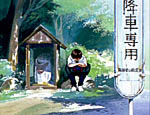FGC:Episode 04 Cut 079: Difference between revisions
m (Automated- Correct default Episode and cut code) |
No edit summary |
||
| Line 33: | Line 33: | ||
{{FGC:Comment|name=Shin-seiki | {{FGC:Comment|name=Shin-seiki | ||
|comment=I'd say it's pretty likely that this was intended as an homage to "My Neighbor Totoro". (NGE is full of such nods to other anime.) [ | |comment=I'd say it's pretty likely that this was intended as an homage to "My Neighbor Totoro". (NGE is [[Tributes_to_Other_Shows_in_Neon_Genesis_Evangelion|full of]] such nods to other anime.) [[:File:Mei-jizo-san.jpg|This image]] of Mei and the statues is included in a book I have about Miyazaki, so I made the connection when I took a good look at the shot of Shinji. | ||
The statue is of [http://www. | The statue is of [http://www.onmarkproductions.com/html/jizo1.shtml Jizo-san], a Buddhist diety who is the patron of travelers and children, and a common sight along rural roads in Japan. Here is the caption for the shot of Mei in the book I mentioned above: | ||
{{FGC:External|text=Seated by a line of statues, Mei wonders what to do now that she is well and truly lost. The statues represent a Buddhist deity who takes care of all children, so the Japanese audience knows she'll be okay… | |||
[Helen McCarthy, “Hayao Miyazaki: Master of Japanese Animation”, p.134] | [Helen McCarthy, “Hayao Miyazaki: Master of Japanese Animation”, p.134]}} | ||
}} | }} | ||
| Line 45: | Line 45: | ||
{{FGC:Comment|name=Reichu | {{FGC:Comment|name=Reichu | ||
|comment=And whoever isn't should be hunted down and shot. | |comment=And whoever ''isn't'' should be hunted down and shot. | ||
Also, here is [http://www. | Also, here is [http://www.japan-guide.com/e/e5202.html more] on the Hakone Tozan Railway. | ||
}} | }} | ||
Latest revision as of 20:11, 5 April 2010
| Screenshots | Cut # | Description/Dialogue | Commentary | |||
|---|---|---|---|---|---|---|
|
|
079 |
|
|

